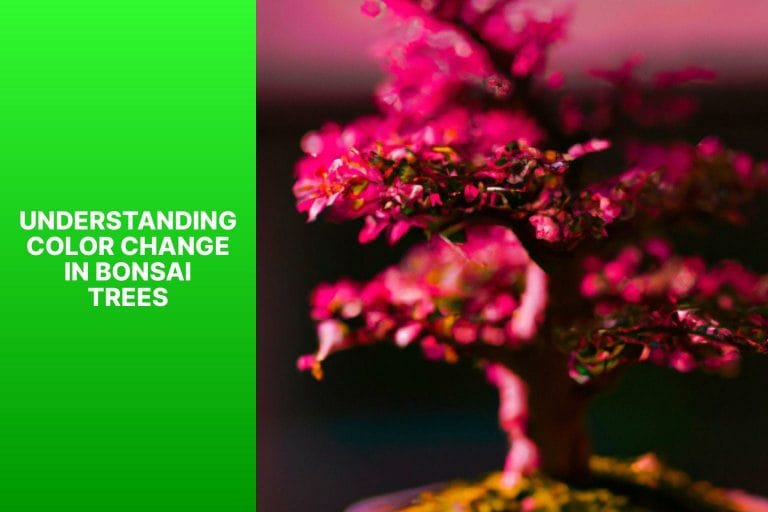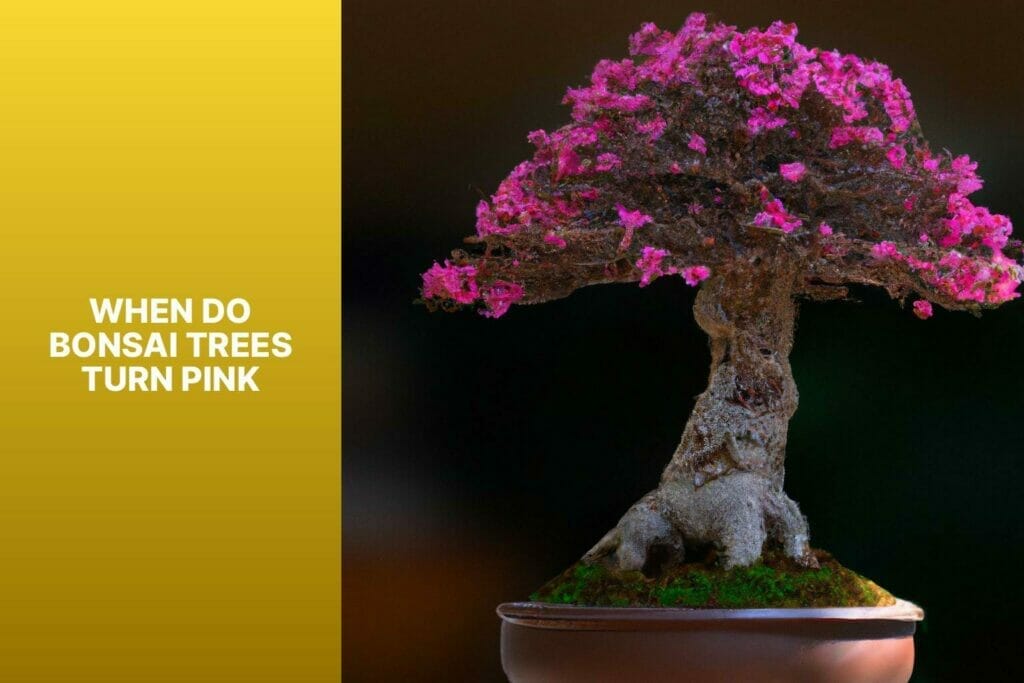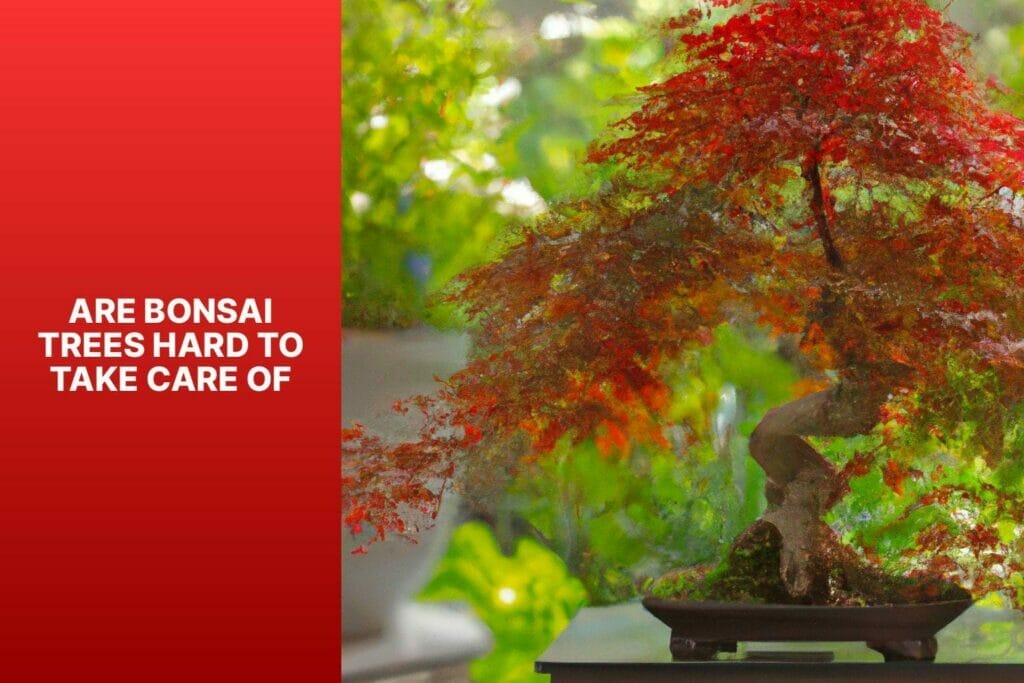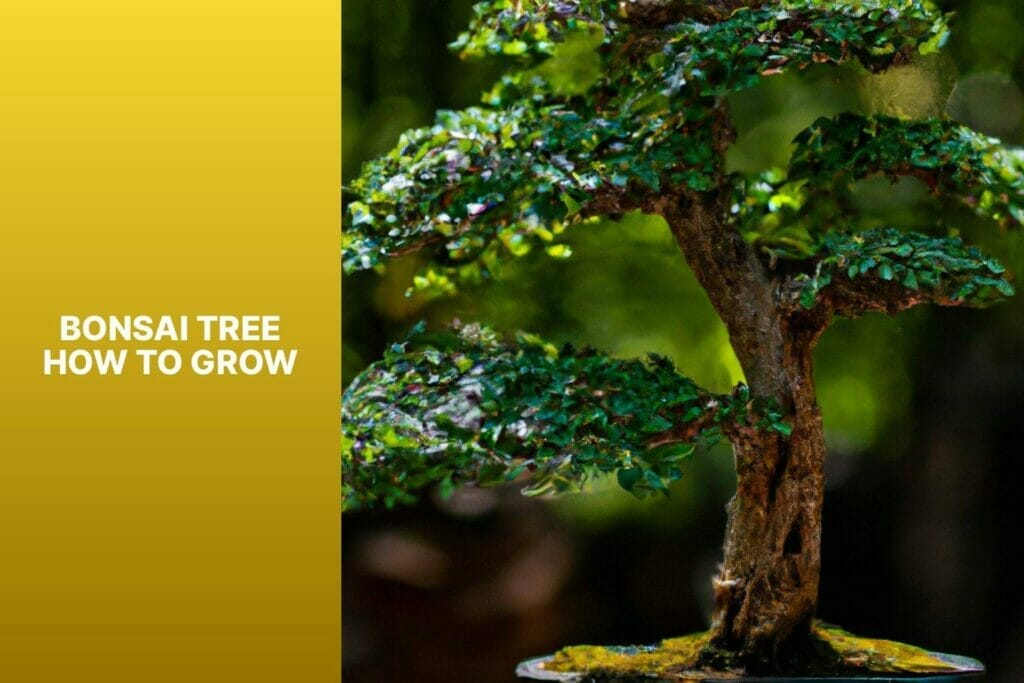Bonsai trees are miniature trees carefully cultivated and shaped to resemble full-sized trees. They bring a sense of tranquility and natural beauty to any space.
One fascinating aspect of bonsai trees is their ability to change colors, adding visual interest and enhancing their aesthetic appeal.
While bonsai trees can exhibit various colors, including pink, the timing of when they turn pink can vary depending on several factors.
Understanding the color change in bonsai trees involves exploring the natural characteristics of these trees and the factors that influence their coloration.
Contrary to common belief, bonsai trees do not naturally turn pink. The color change in bonsai trees results from different factors such as seasonal changes, environmental conditions, and nutritional deficiencies.
Factors contributing to the color change in bonsai trees include seasonal variations, environmental factors like temperature and humidity, and nutritional deficiencies.
During the seasons, bonsai trees may display varying shades of green, yellow, red, white, and even pink. These colors can be influenced by factors such as the species of the tree, the age of the bonsai, the amount of sunlight it receives, and the cultural practices employed in its care.
Specifically, regarding the pink color, the timing of when bonsai trees turn pink can depend on species variations, with certain types of bonsai trees naturally having pink blooms or foliage.
The age of the bonsai tree can play a role, as some species may develop pink colors as they mature. The exposure to sunlight, which affects pigmentation, and the cultural practices involved in caring for the bonsai tree can also impact when it turns pink.
By understanding these factors and the specific characteristics of bonsai trees, enthusiasts can create ideal conditions for their bonsai trees to display vibrant and attractive pink colors.
It is important to note that not all bonsai trees will turn pink, and the color change may not occur simultaneously for every tree.
By providing proper care and attention, bonsai enthusiasts can enhance the chances of their trees developing beautiful pink hues, adding a touch of elegance to their bonsai collection.
Key takeaway:
- Bonsai trees can turn pink: While most bonsai trees have natural colors like green, yellow, red, and white, some species can exhibit pink foliage, adding a unique and vibrant touch to your bonsai collection.
- Factors influencing color change: The color change in bonsai trees can be affected by various factors, such as seasonal changes, environmental conditions, and nutritional deficiencies. Understanding these factors can help bonsai enthusiasts achieve desired color variations.
- Species variations and sunlight exposure: The timing of when bonsai trees turn pink can vary based on the tree species and its exposure to sunlight. Some species may develop pink foliage during specific seasons or when exposed to increased sunlight.
Understanding Color Change in Bonsai Trees

Photo Credits: Mnbonsainetwork.Com by Carl Miller
Color change in bonsai trees is influenced by environmental conditions, species variation, timing, nutrient availability, and care and maintenance practices.
1. Environmental conditions: Cooler temperatures and adequate sunlight enhance color changes in bonsai trees.
2. Species variation: Different species of bonsai trees exhibit varying degrees and patterns of color change, such as turning pink, vibrant red, or orange.
3. Timing: The timing of color change depends on the specific species and its natural growth cycle.
4. Nutrient availability: Adequate levels of minerals and nutrients in the soil stimulate color changes in bonsai trees.
5. Care and maintenance: Proper watering, pruning, and fertilization promote healthy growth and color change in bonsai trees. Regular monitoring and adjustments are necessary.
Bonsai tree enthusiasts can appreciate and cultivate these miniature trees’ remarkable color changes by considering these factors.
Do Bonsai Trees Naturally Turn Pink?
Bonsai trees do not naturally turn pink. The color of these trees is determined by various factors such as seasonal changes, environment, and cultural practices.
While some bonsai species may have pink flowers or leaves, the overall color of the tree is not naturally pink. Sunlight exposure, age, and nutritional deficiencies are among the factors that can influence the tree’s color.
Seasonal changes and environmental factors such as temperature and humidity can impact the color of bonsai tree leaves.
Nutritional deficiencies can alter the color of bonsai trees, but this does not specifically result in pink color. If a tree lacks certain nutrients, its leaves may turn yellow or display other unusual colors.
If you desire a pink color in your bonsai tree, you can select specific species that naturally have pink flowers or choose varieties that can be cultivated to produce pink blooms.
Factors Affecting Color Change in Bonsai Trees
Curious about why bonsai trees change color? Let’s uncover the enchanting factors that influence the beautiful transformation of these miniature masterpieces.
From seasonal shifts to the environment they thrive in and even nutritional deficiencies — we’ll explore how these elements shape the vibrant palette of bonsai trees.
Prepare to be amazed by the captivating secrets behind the ever-changing hues of these delicate horticultural marvels.
Seasonal Changes
Seasonal changes significantly impact the color change of bonsai trees. These changes occur in different seasons, adding diversity and beauty to the appearance of these trees.
During the spring season, bonsai trees showcase vibrant green leaves and blooms in various colors. This time symbolizes renewal and rejuvenation.
In the summer, bonsai trees maintain their green color, representing vitality and abundance. The leaves thrive in warm weather.
As autumn arrives, bonsai trees transform their leaves from green to yellow, orange, and red. This signifies the changing of seasons and highlights the beauty of nature.
Deciduous bonsai trees lose their leaves in winter, revealing their intricate design without foliage.
These seasonal changes enhance the overall aesthetic of bonsai trees, captivating the eye and evoking a sense of wonder and appreciation for the natural world.
I vividly remember the first time I witnessed the seasonal changes in a bonsai tree. As the spring turned into summer, the vibrant green leaves adorned the branches, creating a lush canopy.
With the arrival of autumn, the tree transformed into a fiery masterpiece, its leaves ablaze with shades of gold and red.
In winter, the bare branches showcased the tree’s delicate structure. This experience taught me to embrace nature’s ever-changing beauty and the bonsai trees’ artistry.
Environmental Factors
– Environmental factors such as temperature, humidity, light exposure, air quality, soil composition, and watering practices can all influence bonsai tree color change.
– Higher temperatures can accelerate color changes in bonsai trees, while lower temperatures can delay or inhibit them.
– High humidity promotes vibrant colors in bonsai trees, while low humidity can result in dull or faded colors.
– Adequate sunlight is necessary for proper color development in bonsai trees. Insufficient light can result in pale or less intense colors.
– Air quality, including pollution and exposure to harmful substances, can cause discoloration or damage bonsai trees.
– The composition and fertility of the soil also play a role in bonsai tree color change. Nutrient-rich soil with proper pH levels promotes healthy growth and vibrant colors.
– Proper watering practices are crucial for maintaining bonsai tree color. Drought or overwatering can stress the trees, leading to color changes.
– Seasonal changes, including temperature variations and changes in daylight duration, can impact bonsai tree color change.
Nutritional Deficiencies
Nutritional deficiencies can significantly impact the health and appearance of bonsai trees. It is crucial to address these deficiencies to ensure optimal growth and vitality.
Here are some key points to consider regarding nutritional deficiencies in bonsai trees:
– Macronutrients such as nitrogen (N), phosphorus (P), and potassium (K) are essential for the overall well-being of bonsai trees. Insufficient levels of these nutrients can result in stunted growth, yellowing leaves, and overall poor health.
– Micronutrients like iron (Fe), manganese (Mn), and zinc (Zn) are also important for bonsai trees. Inadequate amounts of these micronutrients can lead to chlorosis, which is the yellowing of leaves between veins. It can cause leaf deformities and make the trees more susceptible to diseases.
– Nutritional deficiencies can also disrupt hormone levels in bonsai trees, thus affecting their growth patterns and the development of flowers and fruits. For example, a lack of phosphorus can inhibit flower formation, while a potassium deficiency can produce poor fruit quality.
To ensure the thriving of bonsai trees, it is vital to provide them with balanced and appropriate fertilizers. Regular soil testing is an effective way to identify nutrient deficiencies and allows for targeted fertilizer application.
Proper watering and drainage practices are critical, as overwatering or poor drainage can impede nutrient uptake.
By promptly addressing nutritional deficiencies, bonsai trees can be healthier and display more vibrant growth and appearance.
Common Colors of Bonsai Trees
Bonsai trees are renowned for their captivating colors, ranging from vibrant greens to delicate pinks. In this section, we’ll explore the common colors of bonsai trees, including green, yellow, red, white, and, of course, the ever-enchanting pink.
Get ready to discover the diverse hues that grace these miniature masterpieces, each exuding its unique charm and adding a touch of nature’s magic to any space.
Green
Green is a common color of bonsai trees, representing vitality and growth. The green leaves of bonsai trees result from chlorophyll, which is responsible for photosynthesis.
Healthy bonsai trees have vibrant green foliage, indicating proper nutrition and care. The green color also signifies a well-balanced environment with adequate sunlight and water.
In bonsai cultivation, maintaining the green color of the leaves is crucial for the tree’s health. The green color can be achieved through proper watering, providing enough sunlight, and supplying necessary nutrients.
Regular pruning and trimming promote new growth and help maintain the green color.
Different species of bonsai trees may have variations in shades of green, from light green to deep emerald.
By choosing the appropriate species, you can cultivate a bonsai tree that matches your desired shade of green.
Yellow
Yellow color in bonsai trees adds visual interest to the tree’s appearance. Understanding the factors contributing to this color is important for maintaining the tree’s health and vitality.
Factors affecting yellow color:
1. Sunlight exposure: Increased sunlight enhances the yellow color of bonsai trees.
2. Nutritional balance: Adequate macronutrients and micronutrients cultivate vibrant yellow foliage.
3. Soil pH levels: Maintaining a pH of 6 to 7 helps maintain a healthy yellow color.
4. Tree variety: Some bonsai species naturally have yellow foliage, while others require specific conditions.
To keep the yellow color vibrant, provide ample sunlight, maintain balanced nutrition, monitor soil pH levels, and select a tree species with naturally yellow foliage.
By considering these factors and providing the appropriate care, you can enhance the aesthetic appeal of your bonsai trees with their stunning yellow color.
Red
The red color of the bonsai trees adds elegance and beauty. Certain species develop vibrant red foliage, especially in autumn. The color change occurs naturally and varies based on species and cultural practices.
Enthusiasts can enhance the redness of the leaves by providing sufficient sunlight and favorable conditions for growth. This increases the bonsai tree’s aesthetic appeal, making it a stunning addition to any collection.
White
White bonsai trees are a stunning addition to any collection. Important points to consider about white bonsai trees are:
- White color: White bonsai trees can have predominantly white leaves or flowers, creating a beautiful and serene aesthetic.
- Common species: Some common species of bonsai trees that can display white color include white flowering cherry, white azalea, and white jasmine.
- Symbolism: In bonsai culture, white color is often associated with purity, innocence, and tranquility. It adds a sense of calmness to your bonsai garden.
- Seasonal variation: The white color in bonsai trees can vary depending on the season. For example, some species may produce white flowers in spring or white foliage in autumn.
- Care requirements: White bonsai trees require the same care as any other tree. This includes proper watering, sunlight exposure, pruning, and fertilization. The specific care instructions may vary depending on the species.
A white bonsai tree brings elegance and a soothing ambiance to your bonsai collection.
Selecting a species that aligns with your preferences and the specific care requirements needed to keep your white bonsai thriving is important.
Pink
Bonsai trees can exhibit a lovely pink hue for various reasons, including species variations, age, and sunlight exposure. Certain types of bonsai, like the Azalea variety, boast stunning pink flowers.
When bonsai trees are younger, they produce more vibrant and eye-catching pink blooms. If they receive increased sunlight, the pink shades become even more intense.
Cultural practices such as utilizing specialized fertilizers or specific pruning techniques can contribute to developing pink tones.
It is important to note that not all bonsai trees undergo this color transformation, and the degree of change can vary. Understanding these factors is vital for bonsai enthusiasts who wish to cultivate and enhance the pink coloration in their bonsai trees.
It is crucial to consider the species, age, sunlight exposure, and cultural practices to achieve a beautiful pink bonsai tree.
When Do Bonsai Trees Turn Pink?
We were wondering when bonsai trees transform into a beautiful shade of pink. Let’s uncover the mystery in this section. We’ll explore fascinating factors that contribute to their enchanting color change.
From species variations to the age of the bonsai tree and the role of sunlight exposure, we’ll unlock the secrets behind the pink transformation. Get ready to delve into the captivating world of bonsai trees and their stunning hues.
Species Variations
Bonsai trees exhibit distinct color change patterns based on their species. Allow me to provide you with an overview of the common bonsai tree species and their respective color change patterns:
– Japanese Maple: During autumn, the leaves of this species transform into striking shades of red, orange, and yellow.
– Chinese Elm: In the fall season, the leaves of Chinese Elm shift from green to hues of yellow, red, and purple.
– Pine: Throughout the entire year, the needles of pine trees maintain their vibrant green color.
– Juniper: This species retains its green foliage all year round, providing a constant splash of color.
– Azalea: The bloom colors of Azalea trees vary depending on the specific variety, offering a selection of pink, white, and red hues.
Understanding the variations in color change among bonsai tree species is vital for enthusiasts of this art form. Such knowledge enables them to select trees that align with their aesthetic preferences carefully.
By opting for different species, bonsai enthusiasts can create captivating displays of color throughout all seasons. They can appreciate the vibrant autumnal hues of Japanese Maples or revel in the evergreen foliage of Junipers.
Each species imparts its unique beauty and charm to the art of bonsai cultivation. By exploring the diverse color variations offered by different species, bonsai enthusiasts can curate an exquisite collection of trees, each with its distinct visual appeal.
Age of the Bonsai Tree
The color change of a bonsai tree is influenced by its age. When considering the age of a bonsai tree, there are several factors to keep in mind:
1. Growth stages: Bonsai trees go through distinct growth stages, each with color changes. For instance, younger trees typically display vibrant green foliage, while older trees may have leaves that turn yellow or reddish.
2. Color intensity: As bonsai trees age, their colors can intensify, particularly in pink species. This means that the pink color becomes deeper and more pronounced.
3. Patina development: The passage of time brings about the development of a unique patina on bonsai trees, which enhances their overall appearance and color, including hues of pink.
4. Species variations: Different species of bonsai trees have varying tendencies to exhibit pink coloring. Some species naturally turn pink at a specific age, whereas others never display pink hues regardless of their age.
5. Environmental influence: While age plays a role in color change, environmental factors such as sunlight exposure and temperature also impact the development of colors in bonsai trees. These factors can either enhance or diminish the presence of pink tones in the foliage.
Understanding how color changes with age allows bonsai enthusiasts to better appreciate the distinctive beauty of these miniature trees at different stages of their lifecycle.
Exposure to Sunlight
Exposure to sunlight plays a significant role in influencing the color change in bonsai trees. To achieve optimal results, it is crucial to take into account the following key points:
1. Sunlight intensity: Bonsai trees require a specific amount of direct sunlight daily. The intensity of sunlight directly influences the color change in the bonsai leaves and flowers.
2. Duration of sunlight exposure: The duration of sunlight exposure also impacts color change. Longer exposure to sunlight enhances the intensity and vibrancy of the colors.
3. Seasonal variations: The different seasons bring varying levels of sunlight. Consequently, bonsai trees may exhibit different colors depending on the amount and intensity of sunlight they receive each season.
4. Positioning the bonsai tree: Proper placement ensures adequate sunlight exposure. Placing the bonsai tree in a location where it receives maximum sunlight exposure during the day will result in more vibrant and attractive colors.
5. Sunlight and photosynthesis: Sunlight is crucial for photosynthesis, which is vital for the growth and development of bonsai trees. Through photosynthesis, plants produce energy and synthesize pigments, leading to changes in foliage color.
6. Managing sunlight exposure: It is important to monitor the amount of sunlight the bonsai species receive to avoid excessive or insufficient exposure. Certain bonsai species may require more sunlight to achieve the desired color changes.
By considering the exposure to sunlight and providing the appropriate conditions, bonsai enthusiasts can successfully cultivate visually appealing trees.
Cultural Practices
Pruning, wiring, repotting, soil management, watering, fertilizing, light exposure, and temperature control are all important cultural practices for maintaining bonsai trees.
Pruning is essential for maintaining the shape and size of bonsai trees, as it involves selectively removing branches or foliage.
Wiring is a technique used to guide branch growth and create desired shapes, adding to the artistic composition of the tree.
Repotting is necessary to provide fresh soil and prevent root overcrowding, ensuring the tree’s health and proper growth.
Proper soil management is crucial as it influences drainage, water retention, and nutrient availability for the bonsai tree.
Watering requires careful attention to provide the right amount of moisture, avoiding overwatering or underwatering. Monitoring soil moisture levels is essential for the overall health of the tree.
Fertilizing is important to supply the necessary nutrients for healthy growth, considering the specific needs of different tree species and growth stages.
Light exposure is crucial for proper photosynthesis and healthy foliage development in bonsai trees.
Temperature control is necessary for optimizing bonsai tree growth and health. Each species has specific temperature requirements that should be maintained.
Some Facts About When Bonsai Trees Turn Pink:
- ✅ Bonsai trees turn pink when they bloom during spring. (Source: The Spruce)
- ✅ The pink flowers on bonsai trees create a stunning visual display. (Source: Bonsai Tree Gardener)
- ✅ Prunus species, including cherry blossom bonsai trees, produce pink and white blossoms in the spring. (Source: Our Team)
- ✅ Bonsai trees should be pruned after the flowers have fallen off to maintain their desired size and shape. (Source: The Spruce)
- ✅ Cherry blossom bonsai trees, a popular variety of bonsai, feature lush plumes of pink and white flowers. (Source: The Spruce)


